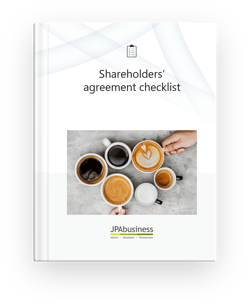
If you’re thinking about starting a business with someone else, or you’re an existing business owner considering taking on an investing party or shareholder, I strongly advise you to create a formal shareholders’ agreement at the outset.
I have dealt with a number of clients over the years who have found themselves in very sad and frustrating situations because they have entered into shareholding arrangements without a documented and legally well-constituted agreement.
Relationships have suffered, friendships have been lost, and business performance and value has been severely eroded through distractions caused as a result of not having an effective shareholders’ agreement.
In this blog I’m sharing the stories of two clients and how the lack of formal agreements has impacted them.
(As always, we’ve anonymised some details about the businesses mentioned to protect all parties’ privacy.)

Client case study 1
This Pty Ltd company operates in the transport and logistics sector. There are three equal partners and they’ve been in business together about 15 years.
All three work in the business full-time, with each contributing to different aspects of the business: general management, finance/corporate services and operations.
The business had grown quite significantly and had some real prospects to grow further.
About two years ago one of the partners decided he wanted to leave the business and asked the other partners to buy him out.
He shared his view on the value of the company, but the other partners disagreed – at the time there was a difference of almost $800,000 between the two estimated values!
These business partners do not have a shareholders’ agreement so there are no ‘rules’ guiding how an exit process of a shareholder should occur.
Instead, the partners have spent two years going hammer and tongs at each other, getting their own valuations conducted and pitting them against each other to try and get to a position where they can decide how to move forward.
It has distracted them from running the business and it has diminished their working relationship.
How we got involved
We had a prior relationship with one of the parties and were finally called in when they were all at ‘peak frustration point’.
Unfortunately, we were too late to undo the damage already done, but we were able to set them on a path to resolution.
We spoke to the parties separately to understand their positions and objectives. From there we were engaged to undertake an independent valuation as decision support for both sides to consider what the business was actually worth on the open market.
We then provided facilitation and mediation services to work through a mutually acceptable solution for the parties ‘to go their own way’.
The result was a good outcome as it finally allowed each of the shareholders to explore their own course. However, the extended process had already weighed heavily in terms of personal stress and business performance, and also impacted senior staff, with confusion and instability over the direction of the business ownership.

Client case study 2
The second client is an engineering business operated by two equal shareholders.
One of the partners contracted a life-threatening disease and, as a result, his focus totally shifted from the business to his family. He wished to withdraw from the business and spend as much time as he might have left with his family.
Again, there was no shareholders’ agreement.
Those partners spent three years fighting about what the price should be on exit.
How we got involved
I was brought in to provide an expert opinion on valuation, as well as decision support for one of the parties.
It was a very, very sad situation and one you never want to see.
Both parties were regretful about the situation, but they felt they had to act in the best interests of themselves and their families, and there was no rule book around how to do it.
Ultimately the parties reached a solution over an extended time – but clearly that was something one of the parties didn’t really have on their side.
Formal agreements valuable, even if they’re only guidelines
In the situations outlined above, a formal shareholders’ agreement would have saved a lot of personal stress, not to mention time and money.
And even if the parties had agreed to go outside the ‘rules’ laid out in their agreement, it would have provided a solid starting point.
In our experience, parties with formal shareholders’ agreements don’t always stick to the letter of the agreement when exiting, but it provides an agreed framework for negotiation and thus allows for the orderly and satisfactory exit of a party.
Use our Shareholders’ Agreement Checklist
We’ve created a free Shareholders’ Agreement Checklist to help readers who are considering taking on an investing party or shareholder.
Use your documented agreement to make clear all parties’ investment and partnership intentions and responsibilities from the outset. And even if you’re already in a partnership or shareholding entity, it’s never too late to put a shareholders’ agreement in place.
If you would like support or advice regarding creating a Shareholders’ Agreement, please contact the JPAbusiness team on 02 6360 0360 or 02 9893 1803 for a confidential, obligation-free discussion.
